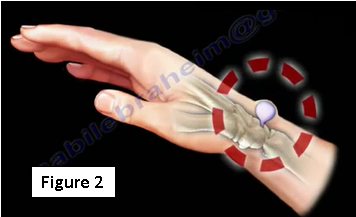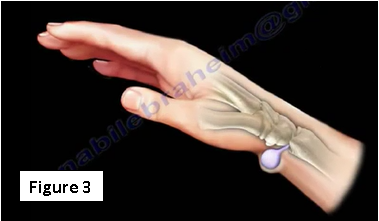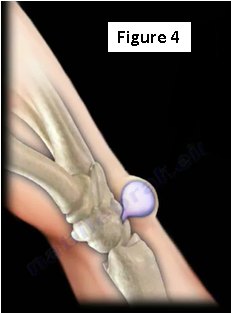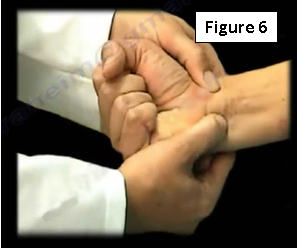Ganglion cyst of the wrist is the most common hand mass and it is not a tumor (Figure 1), the cyst is filled with mucinous (gelatinous) fluid and it transilluminates.

Ganglion cysts of the wrist can be either dorsal or volar. Dorsal cysts are common and not severe, they originate from the scapholunate articulation (Figure 2).

Occasionally, the volar type (rare) occurs and this has cause for concern. The volar type could compress the median nerve or ulnar nerve and possibly compress the artery which will compromise the circulation in the hand. The volar type originates from the radiocarpal joint, which is the wrist joint itself (Figure 3).

Clinical findings
The patient will have a bump or a mass that is well defined, localized, smooth, and not attached to the skin (Figure 4). The dorsal ganglion cyst is obvious with flexion of the wrist. The volar ganglion cyst is obvious with extension of the wrist.

The ganglion cyst in general is usually asymptomatic and the patient is more concerned about the cosmesis. When the physician examines it, they will see that it is a firm mass that can transilluminate (Figure 5).

The physician will do the Allen’s test (Figure 6). During which, the nerves of the hand and the circulation will be checked to make sure that they are not affected.

An MRI is usually not required, however if one is ordered, there is usually a fluid signal seen inside the mass (Figure 7). An ultrasound is an accurate study to check the relationship between the cyst and the vascularity, especially the radial artery with volar cysts. Ultrasound is beneficial during an aspiration when the ganglion cyst is near the artery.

Treatment
In the majority of cases, treatment is observation. In children, the majority of ganglion cysts resolve themselves in about one year. The physician will either leave the cyst alone, perform an aspiration or perform surgery. An aspiration is usually done for dorsal ganglion cysts. There is a high recurrence rate with aspiration of a dorsal ganglion cyst (50%) but there is minimal risk associated with an aspiration. The physician should try to avoid aspiration with volar ganglion cysts because the volar cysts is close to the artery. If the physician performs an aspiration of the volar ganglion cyst, the wrist will be hyperextended to make the artery visible and displace it away from the cyst as the needle is placed in an area away from the artery (Figure 8). It is probably better to do an aspiration of the volar ganglion with ultrasound guidance.
Surgery is done for severe symptoms and if there is a neurovascular compromise. Excision of the ganglion cyst will be done if it is painful, resect the capsule and the stalk. Excision for a dorsal ganglion cyst has less than 10% recurrence rate, while the volar ganglion cyst has a recurrence rate of 20%. The Allen’s test should be done to check the blood flow before doing excision of the volar ganglion cyst.
For more information on cysts, follow the links below:
For more information, visit my YouTube Channel:
